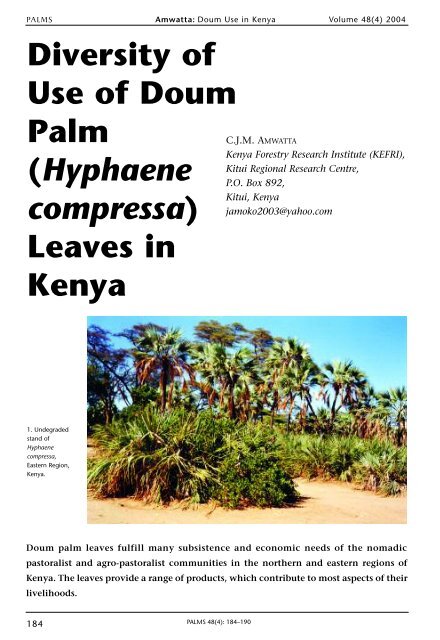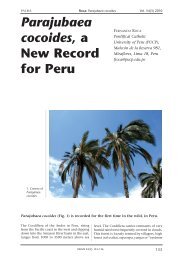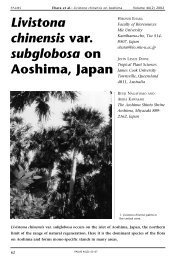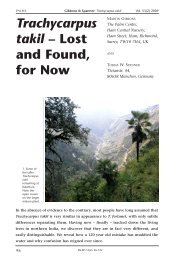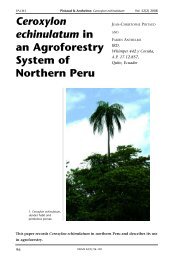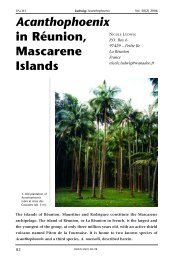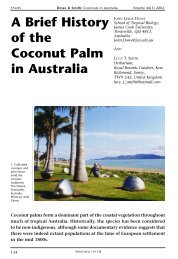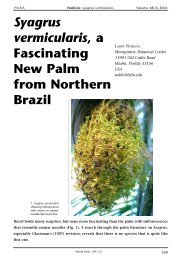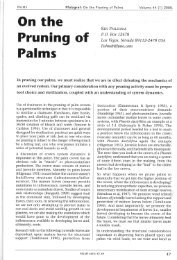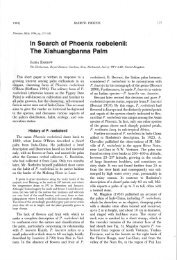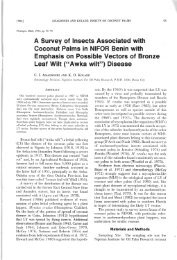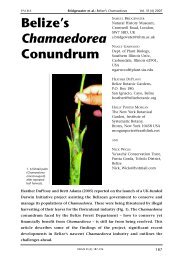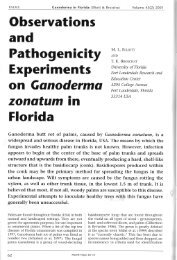Diversity of Use of Doum Palm (Hyphaene compressa) Leaves in ...
Diversity of Use of Doum Palm (Hyphaene compressa) Leaves in ...
Diversity of Use of Doum Palm (Hyphaene compressa) Leaves in ...
You also want an ePaper? Increase the reach of your titles
YUMPU automatically turns print PDFs into web optimized ePapers that Google loves.
PALMS Amwatta: <strong>Doum</strong> <strong>Use</strong> <strong>in</strong> Kenya Volume 48(4) 2004<br />
<strong>Diversity</strong> <strong>of</strong><br />
<strong>Use</strong> <strong>of</strong> <strong>Doum</strong><br />
<strong>Palm</strong><br />
(<strong>Hyphaene</strong><br />
<strong>compressa</strong>)<br />
<strong>Leaves</strong> <strong>in</strong><br />
Kenya<br />
C.J.M. AMWATTA<br />
Kenya Forestry Research Institute (KEFRI),<br />
Kitui Regional Research Centre,<br />
P.O. Box 892,<br />
Kitui, Kenya<br />
jamoko2003@yahoo.com<br />
1. Undegraded<br />
stand <strong>of</strong><br />
<strong>Hyphaene</strong><br />
<strong>compressa</strong>,<br />
Eastern Region,<br />
Kenya.<br />
<strong>Doum</strong> palm leaves fulfill many subsistence and economic needs <strong>of</strong> the nomadic<br />
pastoralist and agro-pastoralist communities <strong>in</strong> the northern and eastern regions <strong>of</strong><br />
Kenya. The leaves provide a range <strong>of</strong> products, which contribute to most aspects <strong>of</strong> their<br />
livelihoods.<br />
184<br />
PALMS 48(4): 184–190
PALMS Amwatta: <strong>Doum</strong> <strong>Use</strong> <strong>in</strong> Kenya Volume 48(4) 2004<br />
2. Products made from<br />
sword leaves <strong>of</strong> <strong>Hyphaene</strong><br />
<strong>compressa</strong>, Northern<br />
Region, Kenya.<br />
<strong>Hyphaene</strong> <strong>compressa</strong> H. Wendl. (doum palm) is a<br />
widespread palm <strong>in</strong> eastern Africa, be<strong>in</strong>g<br />
particularly abundant along the coast <strong>of</strong> Kenya<br />
and Tanzania. In the dry lands <strong>of</strong> Kenya it occurs<br />
<strong>in</strong> isolated populations and is ma<strong>in</strong>ly conf<strong>in</strong>ed to<br />
river<strong>in</strong>e forests (Fig. 1). The palm is common along<br />
the coastal strip, river<strong>in</strong>e ecosystems <strong>of</strong> the drylands<br />
and scattered with<strong>in</strong> open savannah<br />
grasslands (Dale & Greenway 1961, Beentje 1994).<br />
It is most abundant <strong>in</strong> low sandy places and<br />
secondary forests. In the northern and eastern<br />
regions <strong>of</strong> the country, the species contributes<br />
significantly to the livelihood and welfare <strong>of</strong> the<br />
local communities, who are ma<strong>in</strong>ly nomadic<br />
pastoralists and agro-pastoralists. The species is<br />
used <strong>in</strong> several ways. Products rang<strong>in</strong>g from<br />
thatch, ropes, baskets, nuts, dye and medic<strong>in</strong>e are<br />
derived from the species. The doum palm<br />
dom<strong>in</strong>ates forests and woodlands, serves as sources<br />
<strong>of</strong> dry season graz<strong>in</strong>g dur<strong>in</strong>g drought and also<br />
protects the riverbanks. Along the shores <strong>of</strong> Lake<br />
Turkana fourteen different economic uses <strong>of</strong> the<br />
species have been recorded (Awuondo 1990).<br />
Among them leaf was the most used part <strong>of</strong> the<br />
palm. <strong>Leaves</strong> and petioles are the major build<strong>in</strong>g<br />
materials for the manyattas (traditional domeshaped<br />
houses) and makuti (strips <strong>of</strong> mature green<br />
palm leaflets tied <strong>in</strong> a dense row along a leaf stalk)<br />
for the modern houses (see below). <strong>Leaves</strong> are used<br />
to make mats, carpets and baskets for sale. Ropes,<br />
webbed stick wheels (used for bundl<strong>in</strong>g fish) and<br />
wicker baskets (for catch<strong>in</strong>g fish) are made and<br />
sold to fishermen. However, <strong>in</strong>formation about<br />
the full array and magnitude <strong>of</strong> products derived<br />
from the leaves among communities liv<strong>in</strong>g <strong>in</strong> the<br />
dry lands <strong>of</strong> Kenya is <strong>in</strong>complete. Although palm<br />
leaf use by Turkana has been reported (Hoebeke<br />
1989, Awuondo 1990), this is the first time the<br />
different uses by Tharaka, Kamba and Borana<br />
communities have been recorded.<br />
The climate <strong>of</strong> the study area is characterized by<br />
erratic annual ra<strong>in</strong>fall. Apart from fam<strong>in</strong>e relief,<br />
the availability <strong>of</strong> resources that support life, such<br />
as water and forage for livestock, is highly variable<br />
<strong>in</strong> time and space. When livestock productivity<br />
and herd numbers are low, the pastoralists will<br />
seek out alternative livelihoods. In most cases<br />
these will <strong>in</strong>volve activities such as ra<strong>in</strong>-fed<br />
agriculture, the mak<strong>in</strong>g <strong>of</strong> makuti and the weav<strong>in</strong>g<br />
<strong>of</strong> baskets. For <strong>in</strong>stance, the drought <strong>of</strong> 1992<br />
pushed most Turkana pastoralists to resort to craft<br />
activity. The creation <strong>of</strong> a United Nations High<br />
Commissioner for Refugees (UNHCR) refugee<br />
camp <strong>in</strong> the district fuelled the demand for palmbased<br />
crafts. With ever-<strong>in</strong>creas<strong>in</strong>g droughts, more<br />
pastoralists resorted to weav<strong>in</strong>g, lead<strong>in</strong>g to overharvest<strong>in</strong>g<br />
<strong>of</strong> woodlands near urban centers<br />
(Amwatta 1993). Consequently this has led to<br />
reduction <strong>in</strong> quality <strong>of</strong> basketry.<br />
In this study, I exam<strong>in</strong>ed the diversity <strong>of</strong> use <strong>of</strong> the<br />
palm leaves among the four ethnic communities.<br />
The first objective was to document the uses <strong>of</strong><br />
leaves for both domestic and commercial needs.<br />
The second objective was to assess the availability<br />
<strong>of</strong> the leaves for the various needs.<br />
Study area<br />
The study was done <strong>in</strong> the northern and eastern<br />
regions <strong>of</strong> Kenya. The regions lie between 3º 14’N<br />
35º 1’E and 2º 39’S 39º 02’E. The vegetation is<br />
predom<strong>in</strong>antly dry bush-land with pockets <strong>of</strong><br />
185
PALMS Amwatta: <strong>Doum</strong> <strong>Use</strong> <strong>in</strong> Kenya Volume 48(4) 2004<br />
Table 1. Parts <strong>of</strong> palm leaf used by different pastoral communities<br />
Pastoral community<br />
Part <strong>of</strong> leaf used<br />
Sword leaf Mature green Stalk<br />
Turkana Baskets, tablemats, brooms, Traditional thatch, Decoration <strong>of</strong><br />
carpets, ropes, baskets, floor makuti, webbed commercial<br />
mats, lampshades, hammocks stick wheels and build<strong>in</strong>gs;<br />
and hats wicker wicker chairs<br />
Kamba – Mats, brooms Wicker chairs,<br />
door shutters<br />
and cupboards<br />
Borana Sleep<strong>in</strong>g mats and – Decorat<strong>in</strong>g<br />
traditional thatch<br />
shops; walls <strong>of</strong><br />
food stores<br />
Tharaka – Sleep<strong>in</strong>g mats, hats Wicker chairs<br />
baskets and brooms<br />
montane/hilltop forests and <strong>in</strong>selbergs, which are<br />
hot spots <strong>of</strong> endemism. <strong>Hyphaene</strong> <strong>compressa</strong> is<br />
ma<strong>in</strong>ly observed at altitudes <strong>of</strong> 380 – 980 m above<br />
sea level along the marg<strong>in</strong>s <strong>of</strong> lakes, swamps and<br />
rivers. The mean annual ra<strong>in</strong>fall varies between<br />
150 and 600 mm, with mean annual temperature<br />
<strong>of</strong> 36ºC and 38ºC. The soils are calcareous, salty<br />
and alkal<strong>in</strong>e (pH 9), which produces a poor<br />
physical structure. The shore <strong>of</strong> Lake Turkana,<br />
Turkwel River Ecosystems, Meru National Park and<br />
Tsavo West National Park are the areas where the<br />
palm is most abundant.<br />
Methods<br />
Interviews were conducted with farmers, pastoral<br />
women and men weavers, leaf harvesters, vendors<br />
and women’s groups, to compile <strong>in</strong>formation on<br />
the products made, orig<strong>in</strong> <strong>of</strong> products, the users,<br />
methods <strong>of</strong> harvest, prices and the period <strong>of</strong><br />
availability. Major local and regional markets <strong>in</strong><br />
the region were visited and doum palm based<br />
products be<strong>in</strong>g sold listed.<br />
Results<br />
<strong>Palm</strong> leaf use<br />
The most commonly used material from the<br />
species is the leaf. The age at which the leaf is<br />
harvested is dependant on the product to be made<br />
from it. Depend<strong>in</strong>g on the age <strong>of</strong> the leaf when it<br />
is harvested and its treatment afterwards, uses<br />
among the different pastoral communities are<br />
shown <strong>in</strong> Table 1.<br />
Sword leaf<br />
The sword leaf (immature, still closed) is cut,<br />
processed and used to make mats, baskets, hats,<br />
brooms and trays (Fig. 2). The unexpanded leaf is<br />
skillfully cut by push<strong>in</strong>g a machete aga<strong>in</strong>st the<br />
leaf base. The sword leaves, which are about<br />
80–150 cm long, are opened by hand and sun<br />
dried, after which they are split up <strong>in</strong>to long th<strong>in</strong><br />
strips. The long strips are dyed and are then ready<br />
for use or sale to weavers. The number <strong>of</strong> colors<br />
and patterns used differ from community to<br />
community with Turkana and Borana exhibit<strong>in</strong>g<br />
higher skills than Kamba and Tharaka. Among the<br />
Borana weavers, the leaf is cut, opened, split and<br />
woven <strong>in</strong>to f<strong>in</strong>e thatch (gella). The Turkanas beat<br />
the immature closed leaves with a wooden club on<br />
a stone anvil until fibers <strong>in</strong>side are freed to make<br />
ropes. The beaten fibers are also made <strong>in</strong>to str<strong>in</strong>gs<br />
and then woven <strong>in</strong>to open mesh hammocks. The<br />
other tribes did not mention these two uses. In<br />
Turkana, the type <strong>of</strong> use most common was<br />
mak<strong>in</strong>g <strong>of</strong> laundry baskets, which are very popular<br />
with urban dwellers.<br />
Beautiful laundry baskets, floor mats, fruit baskets,<br />
lampshades, tablemats and hats are made out <strong>of</strong><br />
the young leaves. These handicrafts are dest<strong>in</strong>ed<br />
for urban consumers and are traded at local,<br />
national, regional and <strong>in</strong>ternational markets. The<br />
market<strong>in</strong>g <strong>of</strong> these products is specialized,<br />
<strong>in</strong>volv<strong>in</strong>g producers, retailers and wholesalers. The<br />
handicraft cottage <strong>in</strong>dustry has played a crucial<br />
186
PALMS Amwatta: <strong>Doum</strong> <strong>Use</strong> <strong>in</strong> Kenya Volume 48(4) 2004<br />
3. Hut and fence made from mature dry leaves <strong>of</strong> <strong>Hyphaene</strong> <strong>compressa</strong>, Northern Region, Kenya.<br />
role <strong>in</strong> rais<strong>in</strong>g the liv<strong>in</strong>g standards <strong>of</strong> the pastoral<br />
women through the creation <strong>of</strong> jobs, directly or<br />
<strong>in</strong>directly. The large Turkana women’s handicraft<br />
co-operative society handles the sale <strong>of</strong> members’<br />
products. In the eastern region no such market<strong>in</strong>g<br />
society exists, and every weaver sells products<br />
either <strong>in</strong> the local market or to middlemen.<br />
Quality and prices varies from region to region.<br />
The highest quality and hence most expensive<br />
products are found among the Turkanas and<br />
Boranas. For <strong>in</strong>stance, a wedd<strong>in</strong>g mat costs about<br />
$2 whereas the most expensive mat <strong>in</strong> Kamba<br />
would be less than half a dollar. On average there<br />
were 30–45 mat sellers <strong>in</strong> the regional markets <strong>in</strong><br />
the eastern region. Buyers <strong>in</strong>terviewed compla<strong>in</strong>ed<br />
<strong>of</strong> deteriorat<strong>in</strong>g quality <strong>of</strong> mats due to scarcity <strong>of</strong><br />
good quality sword leaves.<br />
Mature leaf<br />
The communities use mature green leaves for a<br />
number <strong>of</strong> purposes <strong>of</strong> which thatch (makuti) by<br />
the Turkana and basketry by other communities<br />
were the most important. Mature dry leaves are<br />
used for build<strong>in</strong>g purposes (Fig. 3) and fire-mak<strong>in</strong>g.<br />
Nomadic architectural styles used by the Borana<br />
and Turkana communities are chang<strong>in</strong>g greatly at<br />
present from dome-shaped huts to modern<br />
rectangular huts. Turkana dome-shaped huts use<br />
dead leaves whereas the modern rectangular use<br />
makuti. The volumes <strong>of</strong> leaves used for the domeshaped<br />
huts are low due to the need for mobility<br />
<strong>in</strong> the seasonal movements. The settled lifestyle<br />
has given greater scope for a range <strong>of</strong> architectural<br />
styles with correspond<strong>in</strong>g higher volumes <strong>of</strong><br />
leaves. Consequently, makuti has become a<br />
commercial commodity and is be<strong>in</strong>g sold <strong>in</strong> local<br />
markets and most <strong>of</strong> it is also used for ro<strong>of</strong><strong>in</strong>g<br />
tourist restaurants and refugee camps established<br />
by UNHCR <strong>in</strong> the northern region. In an effort to<br />
support the local population the UNHCR<br />
encouraged makuti as the sole thatch for the<br />
refugee huts. However, this did not last long. The<br />
scarcity <strong>of</strong> weav<strong>in</strong>g material <strong>in</strong> the vic<strong>in</strong>ity <strong>of</strong><br />
Lodwar and environs became apparent <strong>in</strong> 1993. By<br />
the year 2001, the shortage became alarm<strong>in</strong>g and<br />
UNHCR abandoned the use <strong>of</strong> makuti after protests<br />
from local environmentalists. At the time <strong>of</strong> this<br />
study makuti sale still took place on a small scale<br />
by the refugees (for repairs) and by local people<br />
for thatch<strong>in</strong>g new houses (Amwatta 2002).<br />
In the eastern region mature green leaves are cut<br />
and opened <strong>in</strong>to strips for weav<strong>in</strong>g mats, baskets<br />
187
PALMS Amwatta: <strong>Doum</strong> <strong>Use</strong> <strong>in</strong> Kenya Volume 48(4) 2004<br />
and hats, and mak<strong>in</strong>g brooms. The mature green<br />
leaves were bought from private farms at 2 US<br />
cents per leaf. Due to high demand for the leaves,<br />
cases <strong>of</strong> over-cutt<strong>in</strong>g <strong>of</strong> leaves were observed on<br />
all the farms visited. Frequent conflicts between<br />
the weavers and the national park managers due<br />
to poach<strong>in</strong>g <strong>of</strong> leaves from the protected areas<br />
have been reported.<br />
Leaf stalks<br />
The leaf stalk is a secondary product <strong>in</strong> the<br />
northern region. The stalks are ma<strong>in</strong>ly collected<br />
from dry mature leaves free <strong>of</strong> charge. They are<br />
used for build<strong>in</strong>g, furniture, fenc<strong>in</strong>g and<br />
decorat<strong>in</strong>g tourist hotels/homes (Fig. 4). In the<br />
eastern region, stalks are sold to wicker chair<br />
makers. The traditional wicker chairs are very<br />
popular among the Kambas. Cases <strong>of</strong> people<br />
steal<strong>in</strong>g leaves from private farms to make these<br />
chairs were <strong>of</strong>ten mentioned <strong>in</strong> Kamba area.<br />
Fodder<br />
Cattle and other livestock feed on fresh young<br />
palms or dry leaves dur<strong>in</strong>g droughts. In the eastern<br />
region palms are left scattered <strong>in</strong> the pasturelands<br />
for this purpose. The leaves therefore provide the<br />
dry season fodder <strong>in</strong> the region. No mention was<br />
made <strong>of</strong> this particular use <strong>of</strong> the species <strong>in</strong> the<br />
northern region.<br />
<strong>Palm</strong> leaf availability<br />
Of the 56 weavers <strong>in</strong>terviewed <strong>in</strong> Turkana, 52<br />
(81%) said that they had difficulty <strong>in</strong> obta<strong>in</strong><strong>in</strong>g<br />
leaves for makuti mak<strong>in</strong>g. Thirty (59%) compla<strong>in</strong>ed<br />
that they had to travel a long distance (>3 km) to<br />
source the leaves. Twenty-eight (48%) <strong>of</strong> the<br />
Kamba and fifty-six (84%) <strong>of</strong> Tharaka weavers<br />
<strong>in</strong>terviewed bought all the leaves they used.<br />
Seventy-two (82%) <strong>of</strong> all the weavers <strong>in</strong>terviewed<br />
bought all the leaves they used. The dyed split<br />
sword leaves were sold at 2 US cents.<br />
The species is <strong>in</strong> an <strong>in</strong>cipient state <strong>of</strong><br />
domestication <strong>in</strong> the study area. Turkana, Borana<br />
and Kamba agro-pastoralists spare mature doum<br />
palm trees scattered <strong>in</strong> the farmlands and<br />
pasturelands for provision <strong>of</strong> both products and<br />
services. Among these three ethnic communities<br />
no attempt to plant the species was reported.<br />
Plant<strong>in</strong>g <strong>of</strong> the species us<strong>in</strong>g seeds was reported<br />
among the Tharakas, show<strong>in</strong>g that here the species<br />
is <strong>in</strong> a semi-domesticated state. The ma<strong>in</strong> primary<br />
product driv<strong>in</strong>g these domestication <strong>in</strong>itiatives is<br />
leaf production.<br />
Traditional management techniques<br />
Exploitation <strong>of</strong> palm leaves was susta<strong>in</strong>able under<br />
the traditional resource management systems.<br />
However, the traditional management systems<br />
began to breakdown dur<strong>in</strong>g the last decade<br />
(Barrow 1991). Follow<strong>in</strong>g the settl<strong>in</strong>g <strong>of</strong> the<br />
pastoralists, over-exploitation <strong>of</strong> <strong>in</strong>digenous<br />
woody vegetation and over-graz<strong>in</strong>g <strong>of</strong> the<br />
herbaceous vegetation layers have become<br />
<strong>in</strong>tensive. This has resulted <strong>in</strong> localized loss <strong>of</strong><br />
vegetation cover <strong>in</strong> general and <strong>of</strong> doum palm <strong>in</strong><br />
particular around settlements (Amwatta1993).<br />
Among the Turkana weavers we established that<br />
some traditional management practices to ensure<br />
4. Hotel<br />
veranda<br />
decorated<br />
with leaf<br />
stalks <strong>of</strong><br />
<strong>Hyphaene</strong><br />
<strong>compressa</strong>,<br />
Northern<br />
Region,<br />
Kenya.<br />
188
PALMS Amwatta: <strong>Doum</strong> <strong>Use</strong> <strong>in</strong> Kenya Volume 48(4) 2004<br />
susta<strong>in</strong>able leaf supply still exist. Accord<strong>in</strong>g to the<br />
leaf harvesters <strong>in</strong>terviewed three rules are observed<br />
to achieve this namely:<br />
Reduced leaf harvest<strong>in</strong>g dur<strong>in</strong>g dry seasons<br />
by concentrat<strong>in</strong>g on weav<strong>in</strong>g products such as<br />
brooms and sleep<strong>in</strong>g mats that use fewer<br />
leaves.<br />
If two sword leaves are present, only the larger<br />
one is cut, while the other is left to develop<br />
<strong>in</strong>to a fully expanded leaf.<br />
Only sword leaves between 80–150 cm long<br />
are cut. Cutt<strong>in</strong>g a sword leaves shorter than<br />
50 cm tall will tend to damage the grow<strong>in</strong>g<br />
po<strong>in</strong>t and may result <strong>in</strong> death <strong>of</strong> the shoot.<br />
Discussion<br />
Harvest<strong>in</strong>g <strong>of</strong> doum palm products on a<br />
commercial scale will <strong>in</strong>evitably affect the river<strong>in</strong>e<br />
forests <strong>in</strong> one way or the other. Often the impact<br />
will be significant. Makuti has become a<br />
commercial commodity and is be<strong>in</strong>g sold <strong>in</strong> the<br />
local markets <strong>in</strong> Turkana district. Each piece <strong>of</strong><br />
makuti consumes six mature green leaves (Hoebeke<br />
1989). The species develops six leaves per year<br />
(Hoebeke 1989). Due to rapid <strong>in</strong>crease <strong>in</strong> urban<br />
populations and settl<strong>in</strong>g <strong>of</strong> the pastoralists, the<br />
subsequent high demand for makuti has lead to<br />
over-utilization <strong>of</strong> areas near settled areas and<br />
urban centers <strong>in</strong> the northern region (Amwatta<br />
1999). Awuondo (1990) found that destruction <strong>of</strong><br />
the vegetation cover <strong>in</strong> Kalakol area was ma<strong>in</strong>ly<br />
by the poor and destitute who had been rendered<br />
stockless due to years <strong>of</strong> recurrent droughts. To<br />
them woodland products provide the major source<br />
<strong>of</strong> earn<strong>in</strong>g a liv<strong>in</strong>g. Charcoal, firewood, build<strong>in</strong>g<br />
posts and basketry are some <strong>of</strong> the items <strong>in</strong> high<br />
demand <strong>in</strong> the urban centers, thus provid<strong>in</strong>g a<br />
stimulus for the extraction <strong>of</strong> woodland-based<br />
resources. He further observed that the overexploitation<br />
<strong>of</strong> doum palm demonstrated the<br />
severity with which woodland cover could be<br />
mismanaged <strong>in</strong> a desperate attempt to make<br />
meager liv<strong>in</strong>g <strong>in</strong> the absence <strong>of</strong> perceived or real<br />
alternative.<br />
The species is already classified as threatened due<br />
to habitat degradation (Kigomo 1998). Very little<br />
empirical data exist on how the species could be<br />
susta<strong>in</strong>ably managed. Ratsirarson (1996), while<br />
study<strong>in</strong>g Dypsis decaryi, recommended that annual<br />
leaf harvest<strong>in</strong>g be no more than 25 percent <strong>of</strong> the<br />
leaves per tree per year. Among some <strong>of</strong> the sites<br />
studied <strong>in</strong> both the regions, harvest level was 67<br />
percent, which could affect the regeneration.<br />
However, <strong>in</strong>tensive defoliation was found to<br />
<strong>in</strong>crease density and the number <strong>of</strong> sucker shoots<br />
<strong>of</strong> the species (Oba 1990). However, there is<br />
concern over the possibility <strong>of</strong> reduction <strong>in</strong> the<br />
natural genetic diversity as a consequence <strong>of</strong> the<br />
<strong>in</strong>creased asexual reproduction.<br />
Conclusions<br />
The palm leaf is a resource <strong>of</strong> significant economic<br />
value to the nomadic pastoralists and agropastoralists<br />
<strong>in</strong> the study area. It is the next viable<br />
livelihood alternative, after livestock, for the poor<br />
pastoralists women. The major threats to<br />
susta<strong>in</strong>able availability <strong>of</strong> the palm leaf resource<br />
are widespread over-harvest<strong>in</strong>g, particularly<br />
around <strong>in</strong>creas<strong>in</strong>g permanent settlements.<br />
Clearance for agriculture along the few permanent<br />
watercourses is also a major problem. These factors<br />
threaten the palm leaf base hence the livelihood<br />
<strong>of</strong> the already poor communities.<br />
Recommendations<br />
Efforts should be made to build on and support<br />
the exist<strong>in</strong>g rudimentary management and<br />
<strong>in</strong>formal cultivation <strong>in</strong>itiatives by the agropastoralists.<br />
Research on the quantity <strong>of</strong> products<br />
and their availability should be conducted to<br />
develop management guidel<strong>in</strong>es for leaf<br />
extraction.<br />
Acknowledgments<br />
The study was funded by SAREC through RPSUD<br />
for which I am very grateful. I thank Dr. Jeff Odera,<br />
RPSUD Regional Coord<strong>in</strong>ator, Dr. Paul Konuche,<br />
Director KEFRI, and Dr. Ben Chikamai,<br />
Coord<strong>in</strong>ator, Drylands Forestry Program-KEFRI for<br />
support and guidance. Special thanks to pastoral<br />
communities, weavers and vendors for their<br />
cooperation and support<br />
LITERATURE CITED<br />
AMWATTA, C.J.M. 1993. A prelim<strong>in</strong>ary assessment<br />
<strong>of</strong> the status <strong>of</strong> the <strong>Doum</strong> palm (<strong>Hyphaene</strong><br />
<strong>compressa</strong>) resource <strong>in</strong> Turkana District: A report<br />
<strong>of</strong> a survey done for the Lutheran World<br />
Federation (LWF) and United Nations High<br />
Commissioner for Refugees (UNHCR)<br />
AMWATTA, C.J.M. 1999. The disappear<strong>in</strong>g <strong>Doum</strong><br />
palm. Dry land biodiversity: Biannual Newsletter<br />
<strong>of</strong> the Research Programme on Susta<strong>in</strong>able <strong>Use</strong><br />
<strong>of</strong> Dry land Biodiversity 3:17–19<br />
AMWATTA, C.J.M. 2002. Distribution, Impact <strong>of</strong> local<br />
use and regeneration <strong>of</strong> <strong>Hyphaene</strong> <strong>compressa</strong> <strong>in</strong><br />
the dry lands <strong>of</strong> Kenya. Field Survey Reports<br />
Nos.1, 2 and 3.<br />
AWUONDO, C.O. 1990. Life <strong>in</strong> the Balance:<br />
Ecological Sociology <strong>of</strong> Turkana Nomads. African<br />
Centre for Technology Studies (ACTS) Press,<br />
Nairobi, Kenya.<br />
189
PALMS Amwatta: <strong>Doum</strong> <strong>Use</strong> <strong>in</strong> Kenya Volume 48(4) 2004<br />
BARROW, E.G.C. 1991. Evaluat<strong>in</strong>g the effectiveness<br />
<strong>of</strong> participatory agr<strong>of</strong>orestry extension<br />
programmes <strong>in</strong> a pastoral system, based on<br />
exist<strong>in</strong>g traditional values. A case study <strong>of</strong> the<br />
Turkana <strong>in</strong> Kenya. Agr<strong>of</strong>orestry Systems 14(1):<br />
1–22.<br />
BEENTJE, H. 1994. Kenya trees, shrubs and lianas.<br />
Nairobi, Kenya.<br />
DALE, I. AND P.J. GREENWAY. 1961. Kenya Trees and<br />
Shrubs. Buchanan’s Kenya Estates Ltd. London,<br />
Hatcherds.<br />
HOEBEKE, P., 1989. The <strong>Doum</strong> <strong>Palm</strong> as a biological<br />
Resource <strong>in</strong> Turkana District, Kenya. A Master <strong>of</strong><br />
Science Thesis <strong>in</strong> Biology (Bio resource <strong>in</strong><br />
physical plann<strong>in</strong>g), University <strong>of</strong> Trondheim,<br />
Norway.<br />
KIGOMO, B.N. 1998. State <strong>of</strong> Forest Genetic<br />
Resources <strong>in</strong> Kenya. The Sub-regional workshop<br />
FAO/IPGRI/ICRAF on the conservation,<br />
Management, susta<strong>in</strong>able utilization and<br />
enhancement <strong>of</strong> forest genetic resources <strong>in</strong><br />
sahelian and North-Sudanian Africa,<br />
Quagadougou, Burk<strong>in</strong>a Faso, 22–24 September.<br />
OBA, G. 1990. Effects <strong>of</strong> wildfire on a semi-desert<br />
riparian woodland along the Turkwel river,<br />
Kenya, and management implications <strong>of</strong><br />
Turkana pastoralists. Land Degradation and<br />
Rehabilitation 2.<br />
RATSIRARSON, J., J.A. SILANDER AND A.F. RICHARD. 1996.<br />
Conservation and Management <strong>of</strong> a threatened<br />
Madagascar palm species, Neodypsis decaryi,<br />
Jumelle. Conservation Biology 10: 40–52.<br />
190


